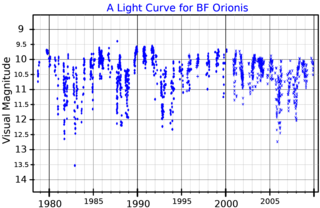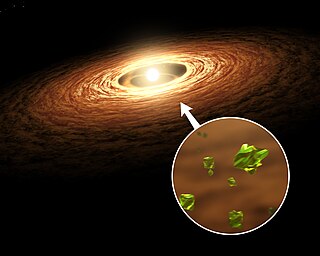
The nebular hypothesis is the most widely accepted model in the field of cosmogony to explain the formation and evolution of the Solar System. It suggests the Solar System is formed from gas and dust orbiting the Sun. The theory was developed by Immanuel Kant and published in his Universal Natural History and Theory of the Heavens (1755) and then modified in 1796 by Pierre Laplace. Originally applied to the Solar System, the process of planetary system formation is now thought to be at work throughout the universe. The widely accepted modern variant of the nebular theory is the solar nebular disk model (SNDM) or solar nebular model. It offered explanations for a variety of properties of the Solar System, including the nearly circular and coplanar orbits of the planets, and their motion in the same direction as the Sun's rotation. Some elements of the original nebular theory are echoed in modern theories of planetary formation, but most elements have been superseded.

A protostar is a very young star that is still gathering mass from its parent molecular cloud. The protostellar phase is the earliest one in the process of stellar evolution. For a low-mass star, it lasts about 500,000 years. The phase begins when a molecular cloud fragment first collapses under the force of self-gravity and an opaque, pressure supported core forms inside the collapsing fragment. It ends when the infalling gas is depleted, leaving a pre-main-sequence star, which contracts to later become a main-sequence star at the onset of hydrogen fusion producing helium.

A protoplanetary disk is a rotating circumstellar disc of dense gas and dust surrounding a young newly formed star, a T Tauri star, or Herbig Ae/Be star. The protoplanetary disk may also be considered an accretion disk for the star itself, because gases or other material may be falling from the inner edge of the disk onto the surface of the star. This process should not be confused with the accretion process thought to build up the planets themselves. Externally illuminated photo-evaporating protoplanetary disks are called proplyds.

An astrophysical jet is an astronomical phenomenon where outflows of ionised matter are emitted as an extended beam along the axis of rotation. When this greatly accelerated matter in the beam approaches the speed of light, astrophysical jets become relativistic jets as they show effects from special relativity.

In astrophysics, accretion is the accumulation of particles into a massive object by gravitationally attracting more matter, typically gaseous matter, in an accretion disk. Most astronomical objects, such as galaxies, stars, and planets, are formed by accretion processes.
Computational magnetohydrodynamics (CMHD) is a rapidly developing branch of magnetohydrodynamics that uses numerical methods and algorithms to solve and analyze problems that involve electrically conducting fluids. Most of the methods used in CMHD are borrowed from the well established techniques employed in Computational fluid dynamics. The complexity mainly arises due to the presence of a magnetic field and its coupling with the fluid. One of the important issues is to numerically maintain the (conservation of magnetic flux) condition, from Maxwell's equations, to avoid the presence of unrealistic effects, namely magnetic monopoles, in the solutions.
The magnetorotational instability (MRI) is a fluid instability that causes an accretion disk orbiting a massive central object to become turbulent. It arises when the angular velocity of a conducting fluid in a magnetic field decreases as the distance from the rotation center increases. It is also known as the Velikhov–Chandrasekhar instability or Balbus–Hawley instability in the literature, not to be confused with the electrothermal Velikhov instability. The MRI is of particular relevance in astrophysics where it is an important part of the dynamics in accretion disks.
Scott Jay Kenyon is an American astrophysicist. His work has included advances in symbiotic and other types of interacting binary stars, the formation and evolution of stars, and the formation of planetary systems.

Rossby Wave Instability (RWI) is a concept related to astrophysical accretion discs. In non-self-gravitating discs, for example around newly forming stars, the instability can be triggered by an axisymmetric bump, at some radius , in the disc surface mass-density. It gives rise to exponentially growing non-axisymmetric perturbation in the vicinity of consisting of anticyclonic vortices. These vortices are regions of high pressure and consequently act to trap dust particles which in turn can facilitate planetesimal growth in proto-planetary discs. The Rossby vortices in the discs around stars and black holes may cause the observed quasi-periodic modulations of the disc's thermal emission.

Noam Soker is an Israeli theoretical astrophysicist. He was the chair of the physics department at the Technion – Israel Institute of Technology from 2009 to 2015.

An accretion disk is a structure formed by diffuse material in orbital motion around a massive central body. The central body is typically a star. Friction, uneven irradiance, magnetohydrodynamic effects, and other forces induce instabilities causing orbiting material in the disk to spiral inward towards the central body. Gravitational and frictional forces compress and raise the temperature of the material, causing the emission of electromagnetic radiation. The frequency range of that radiation depends on the central object's mass. Accretion disks of young stars and protostars radiate in the infrared; those around neutron stars and black holes in the X-ray part of the spectrum. The study of oscillation modes in accretion disks is referred to as diskoseismology.

GG Tauri, often abbreviated as GG Tau, is a quintuple star system in the constellation Taurus. At a distance of about 450 light years away, it is located within the Taurus-Auriga Star Forming Region. The system comprises three stars orbiting each other in a hierarchical triple system, known as GG Tauri A, and another binary star system more distant from the central system, known as GG Tauri B.

Kevin France is an astrophysicist and assistant professor in the Department of Astrophysical and Planetary Sciences at the University of Colorado. His research focuses on exoplanets and their host stars, protoplanetary disks, and the development of instrumentation for space-borne astronomy missions.
Quantum Theory: Concepts and Methods is a 1993 quantum physics textbook by Israeli physicist Asher Peres.

Ramesh Narayan is an Indian-American theoretical astrophysicist, currently the Thomas Dudley Cabot Professor of the Natural Sciences in the Department of Astronomy at Harvard University. Full member of the National Academy of Sciences, Ramesh Narayan is widely known for his contributions on the theory of black hole accretion processes. Recently he is involved in the Event Horizon Telescope project, which led in 2019 to the first image of the event horizon of a black hole.

BP Tauri is a young T Tauri star in the constellation of Taurus about 416 light years away, belonging to the Taurus Molecular Cloud.

BF Orionis is a young Herbig Ae/Be star in the constellation of Orion about 1250 light years away, within the Orion Nebula. It is the most massive star of the small birth cluster of four stars.

Nikolaos Kylafis is a Greek Theoretical Astrophysicist, who is professor emeritus at the Department of Physics of the University of Crete, Greece.

EX Lupi is a young, single T-Tauri star in the southern constellation of Lupus. An irregular variable, it is the prototype of young, low-mass eruptive stars named EXors, with EX Lupi being this object's variable star designation. At its minimal activity level, EX Lupi resembles a classical T-Tauri star of the M0 dwarf type. The low latitude of this star, at a declination of −40°, makes it difficult for northern observers to view. Based on parallax measurements, it is located at a distance of approximately 514 light years from the Sun. The star lies next to a gap in the Lupus cloud complex, a star forming region.












